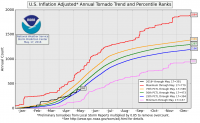The 12z GFS/GGEM support a string of chase days next week for chasecationers and those with lots of money and time. Almost every day from Sunday onward to Thursday/Friday looks conducive to supercells somewhere on the Plains. It's late May, and moisture shouldn't be a problem, so photogenic tornadoes will probably happen on at least a couple days. Whether any of those days shapes up as a high end setup with obvious targets remains to be seen. Sunday has some potential in that regard, albeit flawed at the moment. This morning's runs are also hinting at next Thursday, but that's somewhat of a shift from earlier runs, and too far out to have any confidence.
Still, it's true that we've lacked for classic, synoptically-evident setups in the heart of chase season for a long time now. The 2010s have been pretty rough in that regard, especially since 2010-11. The type of pattern progged for next week isn't especially impressive for this time of year, yet I think my standards have fallen so far since 2011 that I'm excited for it anyway. Granted, the fact that the Plains are completely out of drought and evapotranspiration should be maximized gives some legitimate reason to be optimistic about upcoming "finesse" setups. Royce mentioned 2014 as an analog for the late season, and while that year was simply horrendous before Pilger, I'd argue several setups were severely compromised by drought. The kind of subtle setups seen on several days in late May and early June 2014 *might* have produced decent tornadoes without compromised BL moisture; but, of course, it's impossible to say for sure on any given day. Borderline deep-layer and/or low-level shear do matter, and chasing them constantly in the late spring can lead to frustration and fatigue, even if 1 out of every 3 or 4 such days come through.
On the topic of the PDO: the crude chase season scoring method I developed shows a
clear negative correlation between chase season quality and the mean springtime PDO value. Last year was actually the highest-scoring season with a strongly positive PDO going back to 1955, with 2003 being one other example of a good year. By and large, though, the very highest scoring seasons saw neutral to negative PDO values. At the bottom end, there are a few horrid seasons with a -PDO, but awful +PDO seasons outnumber them. Some of the worst periods in chasing history, such as 1987-88 and 1996-98, coincided with a persistent strongly positive PDO. Suffice it to say, strong +PDO values are not what chasers should be hoping for in future seasons.
The incredibly persistent troughing and cold air over eastern Canada (at times extending into the US Great Lakes/Northeast) for the past 3-4 springs is even more concerning to me. I'm not a climate scientist, so I can't comment on how closely this might or might not be tied to the PDO, or what the causality might be in any such link. You can't help but laugh at recent global temperature anomaly maps showing rampant warmth over 80% or more of the world, but strong negative anomalies lodged over eastern North America, right where we don't want them.

